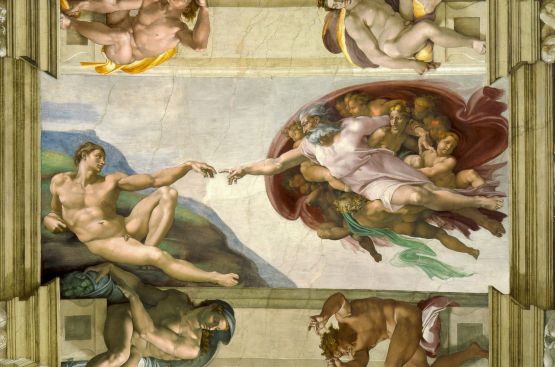It is one of the must-see historic sites of Rome and draws tens thousands of travelers taking vacations in Italy each day.
Five hundred years ago, at evening vespers on October 31, 1512, Pope Julius II officiated a Mass to inaugurate the Sistine Chapel and unveil its crowning touch: the stunning ceiling mural by artist Michelangelo that was newly finished after over four years of toil. The Old Testament stories depicted by the genius Michelangelo create an awe-inspiring place to pray and contemplate spiritual matters and have been considered one of the most important works of art in the world ever since.
The massive frescoes span the entire ceiling, a scale so grand and incredible it is unimaginable until you visit and see it in person. Over 20,000 people visit the Sistine Chapel each day, either lining up to see it during visiting hours or booking small, private tours to skip the long ticket lines and benefit from a knowledgeable guide to lead the tour and discuss the history and artwork.
While most people are familiar with details of Michelangelo’s Sistine Chapel ceiling – notably the image of God reaching out to touch the hand of Adam and give him life – there is so much history behind this magnificent chapel that travelers who take our small group, Vatican Sistine Chapel walking tour are amazed to learn historical facts and scholarly assumptions that make this combination of art and architecture all the more impressive. Four hours is just enough time to really grasp some of the rich history of this Vatican treasure’s secrets.
Here are some facts and secrets to introduce you to the Sistine Chapel:
• The Sistine Chapel is named for Pope Sixtus IV. It was consecrated as a place of worship during a ceremony with the first Mass celebrated there on August 9, 1483. That date was the Feast of the Assumption, fitting since the chapel was dedicated to the Virgin Mary.
• Pope Sixtus IV commissioned many great Renaissance artists to paint frescoes on the walls of the chapel, including Sandro Botticelli, Pietro Perugino, and Pinturicchio.
• Pope Sixtus IV was the uncle of Pope Julius II, who commissioned Michelangelo to create frescoes for the ceiling. Before this the ceiling was rather plainly painted blue with stars, so plain and ugly that Michelangelo was insulted not only because he considered himself a sculptor rather than a painter but because he likened the ceiling to the “roof of a barn.” It took time and the promise of a sculpting commission before Michelangelo consented to re-fresco the Sistine Chapel’s ceiling.
• The sheer scale of the chapel ceiling is staggering. It measures approximately 40 meters (131 feet) long by 13 meters (43 feet) wide – working out to well over 464 square meters (5,000 square feet) of frescoes painted by Michelangelo.










Comments